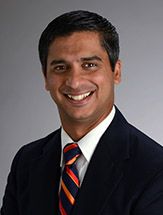A Multidisciplinary Approach to Treating Resectable NSCLC
Surgeons, radiation oncologists, and medical oncologists gathered to discuss treatment options and approaches for NSCLC.
Gregory N. Gan, MD, PhD, Assistant Professor, Radiation Oncology, Director of Oligometastatic and SBRT Program, University of Kansas Medical Center

Alykhan S. Nagji, MD, Assistant Professor, Cardiovascular and Thoracic Surgery, University of Kansas Medical Center

Krishna Reddy, MD, PhD, Associate Professor, Radiation Oncology, University of Kansas Medical Center

Vinay Raja, MD, Medical Oncologist, University of Kansas Medical Center

As part of a Satellite Sessions program focused on the University of Kansas Medical Center, CancerNetwork® hosted a panel discussion on non–small cell lung cancer (NSCLC). The program was brought together to assess the benefits and consequences associated with immunotherapy-based treatment strategies for resectable stage III NSCLC. The panel also discussed biomarkers and gene sequencing in patients with mutations, as well as implications for the use of radiation therapy or resection.
The panel was led by Gregory N. Gan, MD, PhD, assistant professor of radiation oncology at the University of Kansas Medical Center and director of the Oligometastatic and SBRT Program. Panelists included Alykhan S. Nagji, MD, assistant professor of Cardiovascular and Thoracic Surgery; Krishna Reddy, MD, PhD, associate professor of Radiation Oncology; and Vinay Raja, MD, a medical oncologist.
Current NSCLC Landscape
Gan: What is the current landscape for patients with stage III resectable NSCLC?
Nagji: Historically, we would have 2 types of treatment algorithms for a patient with stage III NSCLC. The first would potentially be induction chemotherapy or induction chemotherapy radiation, with the hopes of potentially resecting [the tumors], and if they were unresectable, they would get definitive chemotherapy and radiation. However, over the last decade or so, we have seen a change in the treatment modalities and how we approach these types of patients, from outdated methods to now involving more chemoimmunotherapy and potential resectability of patients with those treatments.
Gan: Dr. Raja, [are you able to] discuss your general approach to biomarker testing for patients with early-stage, non–small cell lung cancer at the University of Kansas, and more specifically, how the testing is conducted? What biomarkers are assessed?
Raja: We used to do the biomarkers for all the stage IV cancers, but now it is essential to incorporate the biomarkers in the early-stage resectable tumors too. There are treatment implications now. Patients with PD-L1 positive [disease] will be eligible for potential adjuvant treatments with immunotherapy. We have neoadjuvant treatments that do not require PD-L1 for using nivolumab [Opdivo], for example, and then you have the EGFR and ALK [mutations]. If they’re positive, we would not want to use immunotherapy. We would want to avoid that–– it can be more harmful than good. That is essential.
Next generation sequencing [NGS] is not the ideal way of testing biomarkers, especially in these settings. I ask for individual biomarkers because they are faster. You get the PDL-1, you get the EGFR, and you get the ALK mutation fairly quickly from your pathologist. That’s all we would need, at least for [diagnosing] the early-stage cancers.
Gan: What are your thoughts [regarding] the use of liquid biopsies, when you cannot get your molecular pathology from solid tissue?
Raja: That happens every so often because you do not have enough tissue on the biopsy. Liquid biopsy would be the next best option. Whenever you cannot get anything out of the solid tumor, liquid biopsy is the way to go.
Gan: How often would you say molecular testing impacts or drives your treatment decisions?
Raja: Certainly, [finding] EGFR and ALK mutations in early-stage cancers, [which can occur in] 10% to 15% of patients, which you would want to avoid. Neoadjuvant immunotherapy, you can still do chemotherapy for these patients. [For] adjuvant treatment we have approval for osimertinib [Tagrisso] after chemotherapy, but for ALK inhibitor, there's a trial going on. The phase 3 ALINA trial [NCT03456076] is currently going on, and hopefully, if there is an approval, that would be another option for the adjuvant setting.1 At this point, EGFR mutation is a definite implication, and EGFR and ALK mutations tell you not to use immunotherapy.
Editor’s note: Since the filming of this program, alectinib (Alecensa) has been approved by the FDA for adjuvant treatment in patients with ALK-positive NSCLC.2
Gan: What is your general approach for determining eligibility for surgical resection at [University of Kansas]?
Nagji: It's a multifactorial approach, and a lot of it is patient-centric. First and foremost, we have to understand can a patient tolerate having surgical resection. Essentially, with surgical resection of lung tissue, you are looking at the ability to tolerate or have a good quality of life after the removal of that lung tissue. We need to focus on their pulmonary function and ability to tolerate having that resection done after the removal of lung tissue. Beyond that, it is also whether the tumor itself is resectable.
The good thing is that we have here at the University of Kansas a robust multidisciplinary tumor conference, that involves the radiation oncologist, the medical oncologist, the pathologist, the radiologist, and myself that evaluate all patients to make sure that we are giving them the best care provider, whether that is surgery up front, vs potentially neoadjuvant therapy, vs sometimes after surgery, whether they need adjuvant therapy too. It is an important aspect to look at the patient as a whole, not only just their medical issues but their quality of life.
Gan: Are there factors that you think would preclude a patient from being able to receive surgery, [such as] any radiographic findings other than the clinical factors you just mentioned?
Nagji: Radiographically, we do evaluate patients with a PET scan, dedicated PET scans, and CT scans. A lot of those give us information as to the lay of the land if you will. When we look at surgery, it has to do with anatomic ability for resection. We are dealing with structures that are coming off of the heart. We are dealing with airway issues. All these things, as they get closer to more major structures, make it more difficult to potentially operate. Then we have to identify those ahead of time. Now, sometimes it does preclude patients from having a surgical resection, but sometimes it allows us to think closely and make sure to see if we can maybe get them through that.
Implementing Leading Trial Results Into Practice
Gan: What are your thoughts on the phase 3 CheckMate 816 study [NCT02998528]?3
Reddy: This was the first landmark study that established the role of neoadjuvant immunotherapy along with chemotherapy for patients with resectable [disease]. Patients with stage I to III resectable, NSCLC were [randomly assigned] to either receive neoadjuvant immunotherapy with chemotherapy vs chemotherapy alone.
The primary end points were event-free survival [EFS] and pathologic complete response [pCR] at the time of surgery. There was an improvement in both of those end points that significantly in favor of neoadjuvant immunotherapy along with chemotherapy. The pCR response rate was dramatic, if I remember something about 20% vs 2% or so, in terms of the pCR when you combined neoadjuvant immunotherapy with chemotherapy.
Gan: In terms of the tolerability of chemotherapy vs now chemoimmunotherapy, Dr. Raja [what are your] thoughts about tolerability?
Raja: Fortunately, immunotherapy is well tolerated, so it is not adding a whole lot to the toxicity and tolerability safety for these patients. The majority of the patients do great. It is only a minority of patients, 2%-3% of patients who may get grade 4 toxicities, which is what comes with immunotherapy, but nothing like adding more chemotherapy to this patient. It is just immunotherapy which is a lot more tolerable.
The phase 3 AEGEAN trial [NCT03800134] is similarly designed.4 We just had an approval for phase 3 KEYNOTE 671 [NCT03425643], with pembrolizumab in the perioperative setting.5,6 You do chemotherapy with pembrolizumab preoperatively, followed by pembrolizumab for a year postoperatively. AEGEAN has a very similar design of chemotherapy with durvalumab [Imfinzi] in the perioperative setting, and then postoperatively, it's durvalumab for a year. Both of these studies showed excellent event-free survival. [KEYNOTE 671] has already been approved, and AEGEAN [likely will follow] in the future.
Editor’s note: Since the filming of this program, durvalumab has been approved by the FDA for perioperative treatment in patients with resectable NSCLC.7
Gan: For some of these patients, we’re getting pulmonary function tests to establish them, but I don’t think that was mandated in the trials after. From a surgeon’s perspective, what are your thoughts and are you concerned with the use of immunotherapy and what that impact could be on lung function?
Nagji: CheckMate 816 did not mandate having post treatment repeat pulmonary function tests prior to any type of surgical intervention. However, what we have seen anecdotally around the country and speaking with some of my other colleagues, is that there’s a significant effect of immunotherapy on lung function, and it comes from a pneumonitis-type picture. What we see is that there’s a decrease in pulmonary function. It may change a patient [with a] borderline resectable [tumor] prior to the initiation of the CheckMate 816, to then suddenly becoming non-resectable, even though they had a good response to the treatment protocol. Sometimes we have to judge whether it is better to go with up front surgery because they are resectable at this point in time, with the risk of potentially not being resectable after a neoadjuvant treatment.
Gan: If you had to get surgery up front and/or maybe you had to just do traditional induction chemotherapy up front: what do we do in the setting after we resected [the tumors]?
Raja: We have approvals for adjuvant treatment for these patients in stages Ib to III. You have the [Impower010 trial] that showed efficacy with atezolizumab (Tecentriq) after chemotherapy, [including] significant improvement in event-free survival [EFS].8 Again, the median EFS is not reached yet. The patients are doing well. The HR there is 0.81–– it is great. Then you have the phase 3 KEYNOTE 091 study [NCT02504372] which showed adjuvant pembrolizumab showing [great benefit] for these patients.9 Excellent EFS for these patients. The HR there is almost 0.76–– a significant improvement there. You have these 2 adjuvant trials [proving] the benefit of immunotherapy in addition to the induction chemotherapy for these patients.
Gan: We also sometimes will see some residual disease, extranodal extension, sometimes the disease is a little too closely adherent or there’s still residual microscopic, in situ disease or low focus diseases just creeping along your airway. I’m wondering, Dr Reddy, what your thoughts are for those situations. What else can we bring to bear in those situations?
Reddy: In selected situations, postoperatively with high-risk features that are amenable to being able to do targeted radiation, postoperative radiation can be considered. Postoperative radiation has, with good reason, fallen out of favor. We certainly do not use it nearly as often as it used to be recommended before clinical trials demonstrated that it did not provide benefit in most patients who have surgery. We have great systemic, adjuvant therapies now with chemotherapy and immunotherapy, but in select cases, adjuvant radiation can be helpful.
Specifically, if a patient has a positive margin in a region that we can localize well, always with the help of our surgeon, in terms of figuring out exactly where that area of risk is. The better we can localize it, obviously, the smaller we can make a radiation target. It makes sense in those cases. In selected cases where you have pleural invasion along the chest wall, if you can, again, localize an area where–– for instance, if Dr. Naji tells me that a tumor was densely adherent, and I can localize that area very well–– we can now do shorter courses of radiation in a targeted way to areas of high risk. In general, when you’re talking about nodal disease or other areas of concern, I would defer to my medical oncology colleagues like Dr. Raja, in terms of systemic therapy being the better option.
Treatment Options After Disease Progression
Gan: What do we do about those patients who progress on adjuvant immunotherapy? What are the next steps that you know we can take for these patients?
Raja: Unfortunately, these are bad actors. Once you’ve failed immunotherapy, the next step is to go back to chemotherapy. Most of the time, it will be a drug that you have not used in the neoadjuvant or adjuvant setting, or there are new trials coming up with antibody drug conjugates. It is all in the pipeline. Hopefully, there will be more drug approvals in the future that we can use, but at this time, we will have to revert back to chemotherapy.
Gan: Is there a role for surgery in individuals who have limited sites of progressive disease?
Nagji: It’s a case-by-case basis, and that goes with anything that we do. That’s where the role of that multidisciplinary tumor conference comes in, where we can sit and truly evaluate the risks, the benefits, and what our next steps would be. Unfortunately, with oligometastatic progression, there's always the argument, “Can additional surgery be done?” It depends on where that oligometastatic disease is. If it is widespread oligoprogression, as you state, the role of surgery has gone by the wayside, if you will. It is always an interesting discussion to be had, and never a door that's closed, but maybe slightly ajar.
Reddy: I agree. These decisions are made in a multidisciplinary fashion, and it’s on a case-by-case basis. With an isolated disease that’s, for instance, in the lung parenchyma, like a recurrent solitary [tumor], another site of disease, in the ipsilateral lung, it’s not unreasonable in someone with an excellent performance status, and good pulmonary function, to consider surgical resection. There are some centers that are aggressive in the use of surgery in these cases and would do that.
Stereotactic body radiotherapy [SBRT] now is a good option. When a patient demonstrates oligometastatic disease, or oligoprogression after surgery, I am in favor of SBRT. Then, it depends on the extent of the disease. If a patient has a regional nodal failure, let’s say a mediastinal node, these are patients that sometimes we consider for chemoradiation with treating the nodes, especially if it was a patient that had no nodal disease at the time of surgery or N1 disease and then now has on imaging, N2 nodal disease.
Our standard, traditionally in recent years, has been to try and salvage this patient who is still potentially curable. With chemotherapy and radiation, targeting the nodal areas at risk, and with concurrent chemotherapy, as we would if the patient had presented with stage III disease, with a mediastinal node, for instance.
Nagji: Potentially the additional role for surgery in these situations would be to obtain more tissue the pathology of the tumor itself may have been the biology. It may have changed a little bit which allows better targeted therapy and potentially additional routes of treatment.
References
- Wu YL, Dziadziuszko R, Ahn JS, et al. Alectinib in resected ALK-positive non-small-cell lung cancer. N Engl J Med. 2024;390(14):1265-1276. doi:10.1056/NEJMoa2310532
- FDA approves alectinib as adjuvant treatment for ALK-positive non-small cell lung cancer. News release. FDA. April 18, 2024. Accessed August 30, 2024. https://tinyurl.com/bd5krdnx
- Forde PM, Spicer J, Lu S, et al. Neoadjuvant nivolumab plus chemotherapy in resectable lung cancer. N Engl J Med. 2022;386(21):1973-1985. doi:10.1056/NEJMoa2202170
- Heymach JV, Harpole D, Mitsudomi T, et al. Abstract CT005: AEGEAN: a phase 3 trial of neoadjuvant durvalumab + chemotherapy followed by adjuvant durvalumab in patients with resectable NSCLC. Cancer Res. 2023;83(suppl 8):CT005. doi:10.1158/1538-7445.AM2023-CT005
- Wakelee H, Liberman M, Kato T, et al. Perioperative pembrolizumab for early-stage non–small cell lung cancer. N Engl J Med. 2023;389:491-503. doi:10.1056/NEJMoa2302983
- FDA approves neoadjuvant/ adjuvant pembrolizumab for resectable non-small cell lung cancer. News release. FDA. October 16, 2023. Accessed March 28, 2024. https://bit.ly/3M3hfyi
- FDA approves neoadjuvant/adjuvant durvalumab for resectable non-small cell lung cancer. News release. FDA. August 15, 2024. Accessed August 30, 2024. https://tinyurl.com/bdecd72v
- Wakelee HA, Altorki NK, Zhou C, et al. Impower010: disease-free survival (DFS) final analysis and secondary overall survival (OS) interim analysis results at ≥5 years follow-up of a phase III study of adjuvant atezolizumab vs best supportive care in resected stage IB-IIIA non-small cell lung cancer. J Clin Oncol. 2024;42(suppl 17):LBA8035. doi:10.1200/JCO.2024.42.17_suppl.LBA8035
- Oselin K, Shim BY, Okada M, et al. Pembrolizumab vs placebo for early-stage non‒small-cell lung cancer after resection and adjuvant therapy: Subgroup analysis of patients who received adjuvant chemotherapy in the phase 3 PEARLS/KEYNOTE-091 study. J Clin Oncol. 2023;41(16_suppl):8520-8520. doi:10.1200/jco.2023.41.16_suppl.8520